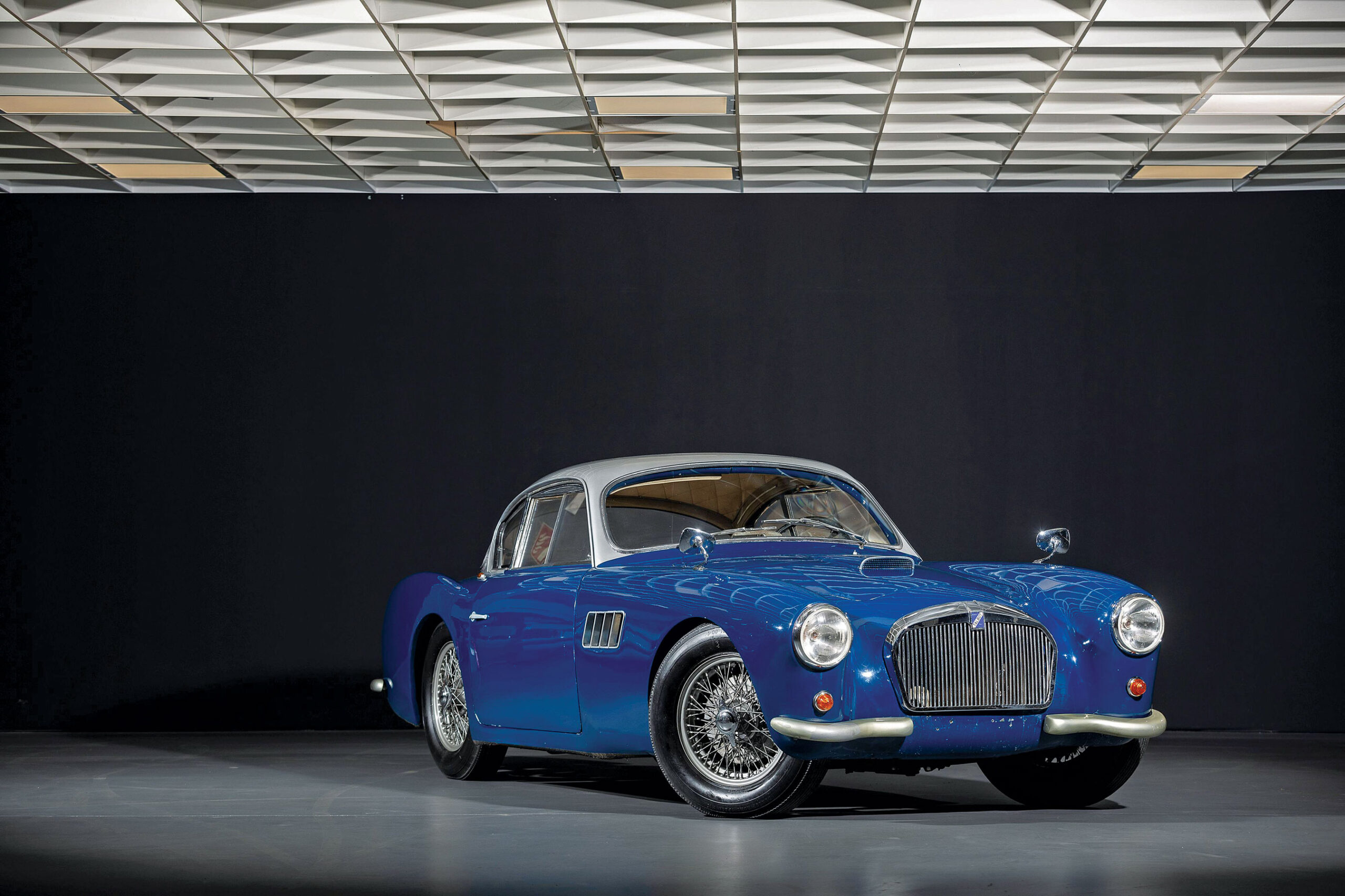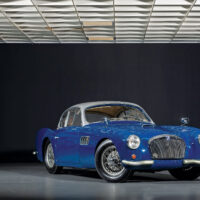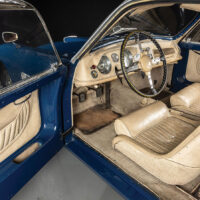The factory record supplied by the Talbot Club states that this example was delivered on December 3, 1957, to a Mr. Cassiers in Belgium. This document confirms that the current engine number is indeed the original one and that the car was painted in Light Blue “Salon,” with “Cordoual matic 250” interior and chromed wire wheels.
The next document linked to this car is a registration certificate from 1971 in the name of Richard von Frankenberg, known as a former racing driver mainly with Porsche (4th at the 24 Hours of Le Mans with a 550 RS factory car in 1955), automotive journalist (Editor-in-Chief of Auto Motor und Sport), author of several historical books and co-founder of the Deutsches Automuseum in 1970, located in Schloss Langenburg and still in existence today. At the time, this Talbot-Lago America was registered CR-J 877. It then made a brief appearance in Holland before being bought in 1972 by Mr. Manfred Kurt Giese near Lake Constance.
It changed hands in the early 1990s and received a FIVA identity card in 1993 in the name of Franz Wunstel in Augsburg. It then joined a major collection based in Memmingen in the south of Germany before its acquisition by the current owner.
This car is now presented in an attractive original condition, with an elegant two-tone paint from around 30 years ago and a beautiful original gray-beige leather upholstery that is part of a sporty and luxurious interior.
With its stunning design by Carlo Delaisse taken from the T26 Grand Sport and reduced “to the pantograph,” this model marked the end of the Talbot era, one of the most prestigious French brands, which stood out both on circuits and concours d’elegance events. This America version benefited from the 2.5-liter BMW V8 engine of the 507, flexible and reliable. Out of 45 examples of the T14 manufactured, fewer than 15 of them had this engine, which makes this car a real rarity, a quality that adds to its beauty and attractive finish.
SCM Analysis
Detailing
| Vehicle: | 1957 Talbot-Lago America |
| Years Produced: | 1955–58 |
| Number Produced: | 14 (est.) |
| Tune Up Cost: | $1,000 |
| Chassis Number Location: | Plate on firewall and stamped on lefthand chassis rail |
| Engine Number Location: | Front-right edge of cylinder head |
| Club Info: | Club Talbot France |
| Website: | http://www.clubtalbot.fr |
| Alternatives: | 1954–57 Jaguar XK 140 1956–59 BMW 503 1953–57 Aston Martin DB 2/4 |
This car, Lot 19, sold for $207,561 (€190,720), including buyer’s premium, at Artcurial’s Paris, FRA, auction on February 2, 2024.
Antonio Lago took over ailing French luxury-car maker Talbot in 1936 and quickly turned it into a success. Production halted during World War II, but Lago used this time to design a new 4.5-liter twin-cam engine to power the post-war version of the existing T26 model. The big car was reasonably successful, but by the early 1950s was showing its age. Lago turned to Carlo Delaisse, who worked for the coachbuilder Letourneur & Marchand, to design sleek new coupe coachwork to sit on the heavy T26 chassis. The result was a work of art, but not enough of them sold to keep the company afloat.
Try, try again
Lago then decided to design and build a new lightweight tubular chassis fitted with a 2.5-liter twin-cam 4-cylinder engine of his own design. The sleek coupe body from the T26 was literally downsized to sit on the shorter chassis. The resulting car, named Talbot-Lago Sport, was simply gorgeous. While the low-slung chassis and all-new suspension resulted in great handling, the engine was flawed. Although technically capable of pulling the car to a respectable 115 mph, it was unreliable and had a tendency to break at high revs.
For some reason, Lago stuck with right-hand drive in the tradition of the great French and Italian marques, limiting the prospective clientele. He also stayed with the French tradition of making the bodies in steel, but then sought to keep the weight down with aluminum front and rear lids and even fiberglass doors in some cars. But the car was expensive compared with the Jaguar XK 120, which was also faster and more reliable. Only about 45 examples were sold between 1955 and 1957. Not enough to pay the costs.
Conscious of the fact that the car was somewhat underpowered and unreliable, Lago knew it needed a new engine. He didn’t have the resources to make one himself, so he went to BMW for the 3.2-liter V8 that powered its 503 and 507, coupled to the excellent ZF 4-speed gearbox. Hoping to attract American customers, he finally agreed to put the steering on the left side, where it always should have been. Full of hope, he christened the car Talbot-Lago America. Then he made his last mistake. European tax laws penalized cars over 2,500 cc, so he asked BMW to reduce displacement to 2,491 cc. The BMW V8 was known for its reliability, but not for power — so why downgrade it when targeting the American market? Nevertheless, the new powerplant offered more performance than the previous one, and top speed increased to 125 mph.
Fun and profit
Chassis 0058B was sold by Artcurial at its annual Rétromobile auction in Paris. It was described as having an “interesting patina,” which can be translated as “needing restoration.” To the car’s credit, its body appeared to be sound, and perhaps the interior was original. The new owner is Swiss, living and working in Malaysia. He will be keeping the car at his holiday home in Southwestern France. The decision has been made to rebuild the car mechanically but leave the rest alone.
Talbot-Lago only made 14 Americas before being forced to sell its prestigious name to Simca-Ford in 1959. Ten were reportedly sold to America, but as there are unquestionably more than four currently in Europe, a few must have come back over the years. Even if they all survived, this is still a very rare car. It’s worth noting that when the brand changed hands, there were four unfinished Americas sitting in the workshop. They were fitted with the totally out-of-date Ford 2.5-liter V8, considerably less powerful than either of the two precedent engines.
Most people would not disagree that the America looks fabulous, and as it’s considerably lighter than a BMW 507, it’s not hard to imagine an owner sourcing a 3.2-liter engine that would probably drop straight in. That would give this car the grunt and speed to make it a true sports car, as the chassis is more than up to taking the extra power.
The America has roughly the same dimensions as a 507, and arguably a better pedigree. It would sit proudly next to the BMW in any garage. Though history has forgotten this car, logic would say that this won’t last forever. All it needs is an owner showing one at some of the big concours events, and potential buyers will wake up. In a few years, this will look like a bargain. But for the new owner of this car, it’s simply an investment in pleasure. Well bought. ♦
(Introductory description courtesy of Artcurial.)




